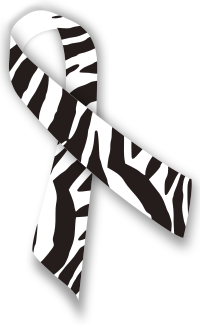Zebra print ribbon

The zebra print ribbon is the awareness ribbon for uncommon or rare diseases and cancers including but not limited to neuroendocrine tumors, carcinoid cancer, Ehlers-Danlos Syndromes, Whipple's disease and awareness of other rare diseases, cancers and disorders.
Origin
The zebra has been used as a symbol for rare diseases since around 1940. Dr. Theodore Woodward, a professor at the University of Maryland's School of Medicine[1] used this term to teach students the basics of diagnosing disease: "When looking at a patient's symptoms, it is better to assume it is a common ailment, not a rare one – a horse rather than a zebra."[1]
Usage
Rare diseases and National Rare Disease Day
National Rare Disease Day (also known as Rare Disease Awareness Day) is held on February 29, but is moved up a day to February 28 on non-leap years.[2][3] This day was launched by the European Organization for Rare Diseases in 2008[4][5] and is now recognized worldwide. The date of February 29 was chosen because it is a "rare day" due to the leap year.[6] The symbol for rare disease awareness is a black and white striped ribbon.[7]
In the US, the National Organization for Rare Disorders brings to light rare diseases, listing and defining more than 1,200 rare diseases that fall under the zebra awareness ribbon.[8]
One of the rarest diseases on the list is the neuroendocrine tumors; this diagnosis has only been given to 2% of the cancers in the US. This cancer can go undiagnosed for a long time due to difficulty in detection and diagnosis.[9]
Whipple's disease, another rare disease on the list, is a bacterial infection that is often mistaken for other diseases, requiring a biopsy of the stomach or duodenum looking for the bacteria Tropheryma whipplei.[10]
Ehlers–Danlos syndromes
The zebra ribbon is also used for awareness of Ehlers–Danlos syndromes, a group of genetic connective tissue illnesses.[11]
See also
References
- ^ a b Dochitect (2016-04-13). "Hearing hoofbeats: time to think zebras? | Dochitect | Medicine and Architecture Integrated. Healthcare Innovated". Dochitect. Retrieved 2022-07-14.
- ^ "NORD Issues New Rare Disease DayⓇ Rallying Cry: Show Your Stripes™!". NORD (National Organization for Rare Disorders). 2019-01-16. Retrieved 2020-06-07.
- ^ "February 29th Is The First Rare Disease Day". Medical News Today. 28 February 2008. Archived from the original on 7 June 2020. Retrieved 14 February 2009.
- ^ Parisse-Brassens, Jerome (December 2007). "29 February 2008: First European Rare Disease Day". European Organisation for Rare Diseases. Archived from the original on September 29, 2008. Retrieved 14 February 2009.
- ^ "History of Rare Disease Day". National Organization for Rare Disorders. 30 January 2024.
- ^ Parisse-Brassens, Jerome (December 2007). "29 February 2008: First European Rare Disease Day". European Organisation for Rare Diseases. Archived from the original on May 23, 2009. Retrieved 14 February 2009.
- ^ "Le ruban zébré, symbole des maladies rares". La Force dmd (in French). 2019-02-05. Retrieved 2022-07-14.
- ^ admin. "List of Rare Disease Information". NORD (National Organization for Rare Disorders). Retrieved 2022-07-14.
- ^ "Understanding the Zebras of the Cancer World". Roswell Park Comprehensive Cancer Center. 10 November 2020. Retrieved 2022-07-14.
- ^ Klochan, Christen; Anderson, Teresa A.; Rose, Dusten; Dimitrov, Rosen K.; Johnson, Raymond M. (10 October 2013). "Nearly Fatal Case of Whipple's Disease in a Patient Mistakenly on Anti-TNF Therapy". ACG Case Reports Journal. 1 (1): 25–28. doi:10.14309/crj.2013.11. ISSN 2326-3253. PMC 4435267. PMID 26157813.
- ^ EDS-F, Bitterlin (2017-06-13). "Zebra Ribbon". EDS-Foundation Netherlands (in Dutch). Archived from the original on 2023-05-02. Retrieved 2020-06-07.
